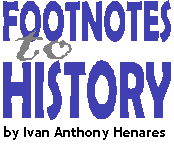|
A Hero Visits Pampanga
Some consider the visit of Dr. Jose P. Rizal to Pampanga and Tarlac as an ordinary overnight trip. But this view may soon change with wealth of new information emerging. As mentioned in an earlier column, Rizal visited a number of houses in San Fernando, Bacolor and Tarlac during his trip in June 1892. But the significance of the trip is not that widely known. It is a little known fact that it played a major role in the history of the Philippine Revolution.
According to Dr. Evangelina H. Lacson during a panel discussion held at the Center for Kapampangan Studies, it was no ordinary visit. Rizal had a mission when he visited the province. And it was to drum up support for the La Liga Filipina.
One of the houses visited by Rizal was the Hilario house in San Juan, San Fernando, where Rizal met with brothers Tiburcio, grandfather of Dr. Lacson, and Cecilio. According to Dr. Lacson, this visit was a turning point for their family. And this is best described by her sister, Ambassador Rafaelita H. Soriano, in her book entitled Shaft of Light. "From legal defenders, reformers and propagandists, they became rebels and leaders of the revolution."
In fact, before the visit, Rizal and the Hilario brothers had not even met. Rizal had heard of the brothers only through a common friend, Valentin Ventura, Rizal's companion in Spain. The word of Rizal's visit spread around that many leaders of Pampanga came to meet him. Before he departed, he distributed pamphlets and booklets on his proposed organization, to the local leaders assembled at the house. He expressed his desire to visit a third Hilario brother, Procopio, who was then residing in Tarlac. The next day, he passed by Bacolor on his way back to Manila, where he was said to visit the Malig and Joven residences.
After that visit, those who attended the meetings were suspected by the Spanish authorities to be collaborators of Rizal. Governor-General Eulogio Despujol ordered the guardia civil to monitor the towns of Lipa and Taal in Batangas, and the provinces of Bulacan, Cavite, Pampanga, and Laguna. The houses visited by Rizal were immediately inspected, including those of the Hilarios, which yielded the pamphlets distributed by Rizal.
Many were jailed, exiled and deported. Tiburcio Hilario was thrown to Siassi, and his brother Cecilio to Balabac. Accroding to Soriano, among the other deportees were Maximino Hizon, Mamerto Lacsamana, Mariano and Felix David, and a Balbuena from Guagua who were all sent to Jolo. She adds that Mariano Alejandrino was exiled closer to home, in the mountains of the Cordillera, while Ceferino Joven was denounced and threatened by the Spanish provincial governor. Ruperto Lacsamana and Antonio Consunji were removed from office.
According to Dr. Lacson, Balbino Ventura, the brother of Valentin, and father of Honorio Ventura, died the very same night he was arrested. A number of the houses visited by Rizal were burned down, including that of the Hilarios.
Putting this information into context, many people claim that Kapampangans did not participate in the early phases of the revolution. But Dr. Lacson counters that Kapampangans were not able to do so because their leaders were exiled early on. How could Pampanga join the revolution when they had no leaders, most of whom were already suffering as early as 1892, under the hands of the Spanish authorities? The revolution in Pampanga thus finds its roots to 1892, when its leaders were exiled to various parts of the country. She adds however, that Kapampangans did in fact participate in the early part, as soldiers of other revolutionary leaders.
It is thus unfair to say that Kapampangans were lukewarm to the aims of the revolution. In fact, Dr. Jose P. Rizal approached many Kapampangans on the La Liga Filipina. It is also vital to look at the timeline of events that followed the visit. Shortly after his trip to Bulacan, Pampanga and Tarlac, Rizal established the La Liga Filipina on July 3, 1892. Rizal was deported shortly after, on July 7, shocking the leaders of the independence movement who saw Rizal as a symbol of freedom. Andres Bonifacio was one of those present when La Liga was established. And during the evening of July 7, Bonifacio established the Katipunan.
Another "what if" thus emerges. What if the leaders in Pampanga and Tarlac were not exiled? What would have happened to the Philippine Revolution if Kapampangans were able to actively participate in the early part of its formation? Thinking about it, who knows, the first Philippine flag could have been unfurled in San Fernando or Bacolor. And the first Philippine President could have been Kapampangan! But of course, these are just "what ifs." What is important is that history corrects the prejudices against Kapampangans and realizes their vital contributions to the cause of the Philippine Revolution.
Please send your comments or suggestions to
ivanhenares@yahoo.com.
We would like
to request those who will be using the information above, especially for
publication, to properly cite the author and the Kapampangan Homepage. The
above column was published in Sun*Star Pampanga.
|
|

